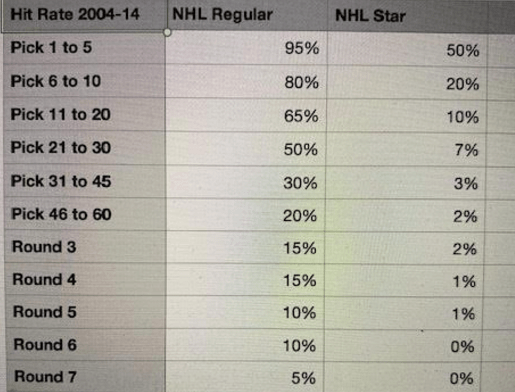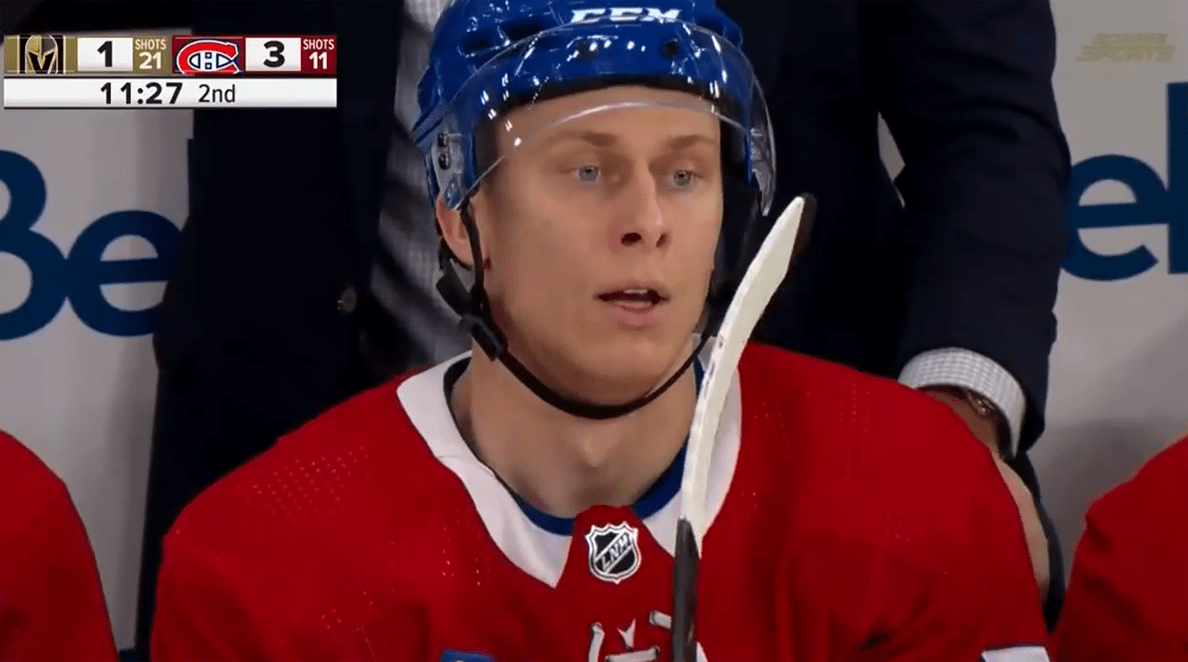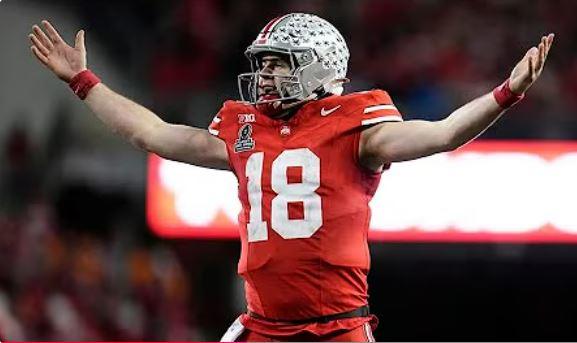If the 2025 NHL draft were held today based on win percentages, the Canadiens would select fourth, 23rd, 35th, and 36th overall.
Given the organization’s depth, with a plethora of high picks in the system and all of the U24 talent on the club, would it make sense to use all of those draft picks? The math tells us it would not. The odds of all four making the club would be very slim. In fact, there is a solid chance that the early second-round picks would struggle to become NHLers, perhaps even the late first-rounder.
Look at Jesse Ylonen, who was drafted 35th overall. He couldn’t find a regular spot on the Canadiens. So what are the chances that three, or even five, years from now, players picked in the 30s in 2025 would be NHLers?
Kent Hughes has already demonstrated that he’s not averse to dealing picks outside of the top 30 to other clubs. He surrendered two picks in the 30s to Colorado for Alex Newhook. Given that there is even more depth now, he would be wise to trade some of those picks.
A team like San Jose is in full rebuild mode and needs as many young players as possible to vie for spots in the future. They could also use a young defenceman who could help them sooner rather than later.
Would a package of the 23rd, 35th and 36th and Justin Barron or Jayden Struble be enticing enough for the Sharks to surrender a top-five pick? Probably not…but you make that inquiry nevertheless. Perhaps you even dangle Alex Newhook. He has a better chance of carving out a top-six role in San Jose than in Montreal in the future.
Statistics show you have a significantly better chance of landing a “star” player with a top-ten or top-15 pick than a pick between 23 and 36. The odds are higher that the Canadiens could move up into the 7-12 range than the top three, but they need to be aggressive in trying to move up. What makes that more likely is Hughes’s history of doing just that. He moved up to take Michael Hage at 21, and in 2022, he tried diligently to move into the top ten to draft Noah Ostlund after trading Alex Romanov to the New York Islanders for the 13th selection.
Here are stats compiled by Montreal Canadiens journalist Brian Wilde regarding the success rate of draft picks made between 2004-14.

An NHL regular was determined to be a prospect playing at least 300 NHL games. A star was 75 per game points as a forward or .50 point-per-game for a defenceman.
So it’s about a 40 percent chance that a player picked 21-40 is a regular and five percent chance he becomes a star in an organization with an average prospect pool. Given that I ranked Montreal’s U25 depth as the best in the NHL and the Hockey News did the same with Montreal’s U-24 depth, I would put those percentages even lower.
Montreal has about 15 prospects with a decent chance of being NHL players, but realistically, there are fewer than eight available positions in the organization. That number decreases even more if they make four selections in the 2025 draft in the top 36.
It is a given that the Canadiens will be making moves this upcoming summer in an attempt to contend in 2025-26. Owner Geoff Molson has been patient, but the “plan” is to have a playoff team next season.
If you remove the goalies from the equation, as there is a decent chance that none will be selected in the top 37, who are the defencemen and forwards in the organization today most likely to have spots in the lineup three years from now?
This would be my guess:
Excellent Chance:
Suzuki
Slafkovsky
Demidov
Caufield
Guhle
Hutson
Reinbacher
Mailloux
2025 top pick
Decent chance:
Laine (likely re-signs
Hage
Beck
Kapanen
Heineman
Roy
Engstrom
A. Xhekaj
Outside chance:
Dach
Newhook
F. Xhekaj
Tuch
Mesar
Davidson
Matheson
Struble
There are 21 positions available for skaters on an NHL roster. If the 18 players who are decent/excellent bets to be on the roster in three years, that leaves three spots for players acquired via trade, free agency, upcoming drafts, or within the organization.
Given that – how many of the three players selected between 22 and 37 in what’s shaping up to be a fairly thin draft class would stand a chance of playing on the Canadiens at any point over the next five years? Remember that four years from now, the first player the Canadiens choose in the 2026 draft will likely be pushing for a spot as well. The same goes for their top pick in 2027, five years from now.
The math tells us that the Canadiens would most likely waste at least two of their first four selections in 2025 if they keep all of those picks. I have a difficult time believing that the players chosen at 23, 35, and 36 in the upcoming draft will be better fits than Roy, Mesar, Newhook/Dach, Tuch, Xhekaj, Struble, or Matheson and whoever else develops well in the system over the next three years.
Jeff Gorton and Kent Hughes will make moves next offseason to be playoff contenders in 2025-26, and that will include dealing at least one of those picks.
They’ll likely try to package all three selections and perhaps a surplus defenceman to move into the top 10. It rarely happens, but few teams have had as many draft picks in the top 36 and a promising young defenceman to dangle.
I also expect Calgary to start slipping in the standings. Let’s say they end up with the 15th pick from Calgary. Would San Jose be interested in a package of Struble and picks 15, 35 and 37 for the third overall pick? That would have to be enticing for a club that is thin on defence and needs one more impactful draft class. The 15th, 34th, and 36th picks would be much more likely to contribute to the Sharks in three years than the Canadiens.
If the Canadiens were somehow to end up with two top-five picks in the 2025 draft class, you want to talk about pedigree! That would give the club seven top-five picks in the organization, six of which would be under the age of 24.
The fact remains that if the Canadiens finish in the bottom five, they will be adding more draft picks at the trade deadline. So even if they dealt three top-37 selections and a young defenceman to move into the top five, it would still likely have one or two second-round picks that they added via trade in early March.
It’s way too early to be etching anything in stone, of course. The Canadiens are a modest win streak away from picking outside of the top ten. Calgary could still finish in the bottom ten, meaning the Canadiens would receive Florida’s first-round pick.
When things aren’t going well in the standings, it is always therapeutic to look at the silver linings. Short-term pain will result in long-term gain if the club ends up picking the top ten again.
Let’s say the Canadiens pull the rabbit out of a hat and end up with two top-four selections in the draft, adding Michael Misa and Porter Martone.
The potential lineup in three years:
Demidov Misa Slaf
Caufield Suzuki Laine/Dach
Hage Beck Martone
Heineman Kapanen Tuch
Roy Xhekaj Mesar
Hutson Reinbacher
Guhle Mailloux
Xhekaj Engstrom
Matheson Barron
Fowler
Montembeault
Dobes
Even if the club were to “only” get either Misa or Martone and keep all of their picks, where are the spots for the three players picked 20-37 in the lineup? Maybe one of them is battling the top-three picks from 2026 and about ten decent prospects, including Roy, Mesar, Davidson, Tuch, and Flo Xhekaj, for one bottom-line roster spot. The prospects pool may include draft picks collected for Dvorak, Anderson, Struble, Evans, Savard, Newhook, Laine/Dach and perhaps even Matheson. It’s also quite possible that the return for those players includes some NHL players or drafted prospects.
The bottom line—the roster depth and math tell us that the Canadiens will be proactive this offseason in trading draft picks/players to get better sooner rather than later. They aren’t about to ice a 40-man roster. The next eight months are going to be eventful ones for Kent Hughes.






